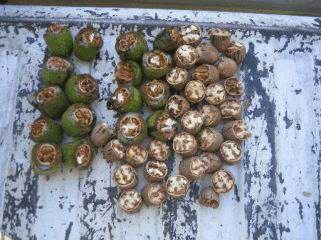
- Rosette (Zinc Deficiency)
- Mouse-Ear (Nickel Deficiency)
- Nitrogen (N) Deficiency
- Nitrogen:Potassium Imbalance (Nitrogen Scorch)
- Nitrogen:Phosphorous Imbalance (Scorch)
- Magnesium Deficiency
- Iron Deficiency
- Water-Stage Fruit Split
- Shuck Decline
- Delayed Shuck Split / Vivipary/ Cracked Shells
- Freeze Damage
- References
Although many problems regarding pecan production result from pest or disease pressure, the crop may also be adversely affected by nutritional imbalances, nutrient deficiencies, or environmentally induced disorders. These are some of the more difficult problems to diagnose. Some nutrients may be more available than others on certain soil types and under certain soil conditions. Additionally, complex interactions often occur between nutrients, which influence uptake by the pecan tree. Pecans can also be quite sensitive to environmental conditions, which stress the tree, limiting its growth and productivity.
Rosette (Zinc Deficiency)
One of the most common nutritional disorders of pecan in Georgia is pecan rosette, which is usually a sign of zinc (Zn) deficiency. Rosette begins as chlorosis and curling or twisting of young leaves. The condition is first visible in the terminal leaves or the terminal leaflets of compound leaves. As the problem progresses, further chlorosis and wavy leaf margins develop (Figure 1). This includes the narrowing of the leaves, necrosis between veins and terminal dieback (Figure 2). Affected trees may take on a rusty brown or yellow-green color, particularly near the tops of the trees.
 Figure 1. . Note wavy leaf margins and interveinal chlorosis.
Figure 1. . Note wavy leaf margins and interveinal chlorosis. Figure 2. Terminal die-back due to zinc deficiency in pecan tree.
Figure 2. Terminal die-back due to zinc deficiency in pecan tree.Rosetted areas in the tree may green up in the spring before the remainder of the tree. Do not confuse this symptom with bunch disease, which also greens up earlier in the spring.
While the lower end of the recommended range of Zn concentration in pecan leaf tissue is 50 ppm, zinc deficiencies often become visible when leaf Zn is less than 40 ppm. Zinc availability is reduced on alkaline soils, but on acid soils, soil applied zinc sulfate or zinc oxide can maintain adequate Zn levels in mature trees. Even under ideal conditions, uptake of zinc is slow; foliar zinc sprays are the fastest method of moving zinc into the tree canopy. Leaf absorption of zinc is not very efficient after leaves harden off. Properly timed sprays are required to eliminate any deficiency problems. Band applications of zinc sulfate or zinc oxide, at 5 pounds per tree, placed along the drip emitters have also been successful in increasing zinc uptake relatively quickly in acidic soils where availability has been a problem.
Continuous application of zinc when not needed can lead to serious side effects, particularly with nickel and copper nutrition. Therefore, monitor zinc needs via annual leaf analysis. Apply foliar zinc only when leaf zinc levels are below 50 ppm and/or visual symptoms of zinc deficiency are seen.
Mouse-Ear (Nickel Deficiency)
Mouse-ear of pecan is a growth abnormality caused by a deficiency of available nickel in the pecan tree. This disorder was initially attributed to spring cold injury before bud break, and was later thought to be the result of a viral pathogen. At various times, the problem has also been considered a manganese deficiency or a copper deficiency. Only recently, the discovery was made that mouse-ear is a symptom resulting from a severe nickel deficiency. Nickel is required by the urease enzyme in plants for the efficient conversion of urea to ammonia. The disorder occurs most frequently on newly transplanted trees in established orchards, but can also occur on sites where pecan has not previously been grown.
Mouse-ear first appears on the spring growth flush. The most common symptom of mouse-ear is a rounded or blunt leaflet tip (Figure 3). Affected leaves and leaflets are often smaller than healthy foliage. The rounded leaflet tips result from the buildup of lactic acid to the point of toxicity in the leaf tissue.
Other symptoms of mouse-ear include dwarfing of tree organs, poorly developed root systems, rosetting (Figure 4), delayed bud break, loss of apical dominance, necrosis of leaflet tips (Figure 5), and reduced photoassimilation. Symptoms may occur throughout the entire tree or sporadically throughout the canopy, often evident only on a single major limb or terminal shoot (Figure 6). Mouse-ear may consistently reappear from year to year or appear only occasionally on the same trees. The degree of severity within the tree canopy typically increases with canopy height.
 Figure 3. Mouse ear symptoms of pecan.
Figure 3. Mouse ear symptoms of pecan. Figure 4. Rosetting of pecan due to nickel deficiency.
Figure 4. Rosetting of pecan due to nickel deficiency. Figure 5. Necrotic leaf tips in pecan tissue due to the build-up of lactic acid, resulting from a nickel deficiency.
Figure 5. Necrotic leaf tips in pecan tissue due to the build-up of lactic acid, resulting from a nickel deficiency. Figure 6. Pecan tree suffering from severe nickel deficiency.
Figure 6. Pecan tree suffering from severe nickel deficiency.
A variety of abiotic and biotic factors may influence mouse-ear. Severely affected orchards typically have high soil levels of zinc, calcium, magnesium, and phosphorous but low copper and nickel. These orchard soils are also normally acidic and sandy in texture, with low cation exchange capacities. Nematodes are commonly associated with the roots of affected trees as well.
Easily correct mouse-ear by applying nickel as a foliar spray in early-mid April when the developing foliage is in the parachute stage, or shortly thereafter, since nickel is not absorbed well by young leaves until the plant is in the parachute stage. In severe cases, make an additional application in late September or early October to prevent mouse-ear in the following initial spring flush. The nickel will be stored in the buds and stem tissues over the winter, where it will be available to the tree at bud break. Follow all label directions when using foliar nickel sprays.
In order to manage orchards for the prevention of mouse-ear, take the following steps:
- Monitor leaf tissue and soil samples regularly for the availability of nickel to pecan trees.
- Do not make excessive applications of zinc to mouse-ear prone orchards. Zinc competes with and inhibits the uptake of nickel by pecan roots from orchard soils. Only apply foliar zinc when zinc levels in the leaf are less than 50 ppm or when visual symptoms of zinc deficiency are present in the orchard. Repeated foliar applications of zinc to the orchard result in substantial accumulation of zinc in the soil, mainly concentrated around the base of trees due to the rinsing of foliar applied zinc down the scaffold limbs and trunk. Do not allow soil zinc levels to increase in sandy or acidic soils already low in nickel.
- Maintain adequate soil moisture at bud break. Since nickel is at relatively low levels in most orchard soils, and its absorption by the tree is among the lowest of many nutrients, it is important to maintain soil moisture in order to facilitate root uptake.
- Maintain soil pH of 6.5-6.8 for efficient uptake of available soil nickel.
- Mouse-ear prone sites should not receive excessive applications of nitrogen unless applying nickel to the foliage.
- Avoid excessive applications of calcium and magnesium to mouse-ear prone sites. Most of the calcium and magnesium applied to orchard soils is in the form of dolomitic lime; therefore, take care not to over-lime orchard soils.
- Carefully manage phosphorous, iron, and copper levels in orchard soils, especially on sandy or acidic sites. These nutrients affect the uptake of nickel by pecan roots. Additionally, they may alter the availability of nickel within the pecan leaf.
- Correct nickel deficiency via foliar sprays and not by soil application.
Nitrogen (N) Deficiency
Moderate to severe symptoms of nitrogen deficiency are rare in commercial pecan orchards. However, symptoms may appear when the trunk is damaged from cold injury or when growing on soils that remain wet for long periods in early spring. If a nitrogen deficiency is present, it may also mask the symptoms of other nutrient deficiencies.
When leaf N concentrations fall below 2.2 percent, deficiency symptoms may begin to appear. The most common symptom of nitrogen deficiency in pecan is a general yellowing (chlorosis) of the leaves. A subtle interveinal chlorosis pattern is often evident as well. Symptoms begin as a slight fading, which progresses to a pale yellow and eventually a bright gold. A faint green line adjacent to the veins often remains visible before fading as the leaves get older. It is noteworthy that sulfur deficiency can sometimes produce pale green foliage that at first glance appears to be a N deficiency.
Deficiency symptoms begin on the basal leaflets of basal compound leaves and progress upward, ultimately leading to premature defoliation, small nuts and limited production. Atypical environmental conditions may alter this pattern to a certain extent. In severe cases, symptoms may appear during leaf expansion, but they normally are not apparent until later in the season. The greatest degree of symptom expression occurs in late autumn. Annual applications of 75-200 pounds of N per acre, depending upon crop load, will maintain adequate N supplies for the tree.
Nitrogen:Potassium Imbalance (Nitrogen Scorch)
One of the most widely occurring nutrient disorders of pecan in the southeast is nitrogen scorch, which results from an imbalance between N and K. In most cases, the scorching is restricted to the base of the leaflet (Figure 7). Severe cases may result in marginal leaflet scorch and premature defoliation. Scorched areas may be circular or oblong and about the size of a dime. Scorching is initially a deep, rich, brown color and may fade to grayish brown later in the season if defoliation does not occur. Scorching first appears on the basal leaflets of basal leaves and progresses upward. Leaf abscission or defoliation follows this same pattern. Early symptoms of an N:K imbalance are an irregular interveinal chlorosis (Figure 8).
 Figure 7. Leaf scorch of pecan resulting from an imbalance between nitrogen and potassium. A similar scorching can occur due to an imbalance between nitrogen and phosphorous. The two can be separated by the timing of symptoms. N:K scorch occurs in mid-summer. N:P scorch occurs 7-10 days before shuck split.
Figure 7. Leaf scorch of pecan resulting from an imbalance between nitrogen and potassium. A similar scorching can occur due to an imbalance between nitrogen and phosphorous. The two can be separated by the timing of symptoms. N:K scorch occurs in mid-summer. N:P scorch occurs 7-10 days before shuck split. Figure 8. Early symptoms of N:K deficiency.
Figure 8. Early symptoms of N:K deficiency.The N:K balance induced scorch is associated with a particular stage of leaf development. Scorching and defoliation may occur in May in severe cases, but it normally occurs in June and early July. When defoliation occurs in early May, it may be accompanied by very little to no scorch. The peak of scorch usually occurs over a 2-4 week period. The rate of scorch normally subsides once this stage had passed. The severity of leaf scorch may range from almost no defoliation to 90 percent by the end of July.
This disorder is most common on young (less than 10 years old) trees. If you continually add N to the orchard soil without the addition of potassium, scorching will eventually occur. Potassium may be tied up in the soil, even when present at sufficient or excessive levels, by high soil Ca and/or Mg. When this occurs, and heavy rates of N are applied, scorch may be induced.
Potassium deficiency can lead to poorly filled nuts, excessive nut drop, a reduced tolerance to cold weather, and reduced yield. Desirable and Schley trees appear to be most sensitive to potassium deficiency, and leaf levels should be monitored closely.
While maintaining adequate soil K levels is important, soil applied K is often ineffective as a means of correcting the N:K imbalance in the short term. Other factors influencing uptake of soil K include soil N, Ca, Mg, and soil pH. As a result, K can be slow to move into the tree, especially on clay soils, when conditions are not ideal. Surface applications of K on sandy soil may generate a response by the tree in as little as one year but will take longer in heavy clay.
 Figure 9. Potassium banding along the drip emitters.
Figure 9. Potassium banding along the drip emitters.Where known problems exist, carefully monitor potassium status of the leaf before and after N application. When K is marginal or at a deficient level, it is better to reduce the amount of N applied until leaf K levels are adequate. If correcting scorch relatively quickly, K should be banded as potassium chloride along drip emitter lines at a rate of 8 pounds of material per tree (Figure 9). Make applications at or near bud-break or during kernel-fill if symptoms appear or when leaf levels indicate a need. Apply N and K at a ratio of 1:1.5 or 1:1.2 to K deficient trees.
Application of foliar sprays, using 2-4 pounds of potassium nitrate per 100 gallons of water with the second and third cover sprays, may be beneficial in reducing K deficiency the first and second years following diagnosis. Results are often inconsistent with foliar applications of K. Potassium is absorbed by the leaves but usually in small amounts.
Keep N:K leaf ratios at or near 2:1 in order to maintain an appropriate balance between N and K. Additionally, leaf N:K ratios above 2.5:1 are associated with reduced yield when trees are bearing a heavy crop.
Nitrogen: Phosphorous Imbalance (Scorch)
Phosphorous deficiency can be easily overlooked in pecan. The primary symptom of phosphorous deficiency is a dull green foliage color with no interveinal chlorosis. With no comparison, this can easily be mistaken for nitrogen deficiency. Additional symptoms may include thin stems, and small or poorly filled nuts. Deficiencies may begin at leaf concentrations at or below 0.12 percent.
In prolific varieties, phosphorous deficiency may be expressed as a marginal scorch and premature defoliation similar to what is seen with the N:K imbalance. The primary difference between the two scorching disorders is that with a N:P imbalance, scorching begins later in the growing season, approximately 7-10 days before shuck split.
Phosphorous uptake is not closely related to soil phosphorous levels in pecan. Control of the N:P scorch by a soil phosphorous application is often unsuccessful. Phosphorous moves very slowly through the soil profile, only ½ to 1½ inches per year, depending on soil texture and water. As a result, uptake by the tree is slow. Shallow incorporation of phosphorous by discing the soil may help with uptake by the tree. Excessive concentrations of P in the foliage can lead to physiological deficiencies of zinc, copper, and nickel.
Magnesium Deficiency
 Figure 10. Magnesium deficiency symptoms showing “Christmas Tree” pattern.
Figure 10. Magnesium deficiency symptoms showing “Christmas Tree” pattern.Magnesium deficiency is relatively rare in pecan; however, it can occur in trees growing on dry, acid, or sandy soils, especially in orchards with high soil potassium levels. Magnesium deficiencies are characterized by a marginal and, eventually, an interveinal chlorosis, which forms a “Christmas tree” pattern on the leaflet (Figure 10). In very severe cases, a marginal leaf scorch may follow chlorosis. Symptoms normally develop in mid-late summer.
Magnesium deficiency is best prevented by maintaining soil pH at 6.0-6.3 and by the use of dolomitic limestone as a liming material. Dolomitic limestone contains calcium and magnesium, and generally provides an adequate amount of magnesium for most orchards. Growers are usually able to observe increases in their leaf magnesium concentrations during the second growing season following application.
Where trees are identified as magnesium deficient, magnesium sulfate is more effective at raising leaf magnesium concentration, because it is more water-soluble. Deficient trees will respond more quickly to foliar sprays of magnesium sulfate (5 pounds per 100 gallons) applied from the first leaf stage through July, but soil application of magnesium is still necessary to maintain adequate levels in orchard soils.
Iron Deficiency
Iron deficiency of pecan occurs early in the growing season, usually from mid April to early May, and will usually clear up as the season progresses. In the humid south, iron deficiency is more of a problem with mature trees than with young trees. The reverse is true in the more arid western regions of the United States.
 Figure 11. Iron deficiency of pecan.
Figure 11. Iron deficiency of pecan.In pecan, as with most plants, iron deficiency rarely occurs due to lack of iron in the soil. Rather from the unavailability of iron. This is normally caused by over-liming, cold, wet soils in the spring, or high soil zinc, phosphorous, or manganese.
Classic iron deficiency symptoms are a pronounced interveinal chlorosis (Figure 11). From a distance, iron deficiency, at first, may be perceived to be a nitrogen deficiency. However, with iron deficiency young leaves and leaflets are affected first, which is the opposite of typical nitrogen deficiency. Although leaf veins normally remain conspicuously green, leaf veins may also become chlorotic with iron deficiency.
Foliar applied iron has had varying results in the correction of iron deficiency on pecan. When caused by acid soil conditions, liming to a soil pH of 6.5 can correct the problem. In most cases, the condition results from cool, wet spring conditions and will clear up as the season progresses and soil conditions improve.
Water-Stage Fruit Split
 Figure 12. Water stage fruit split of pecan showing the external splitting. The external crack in the shuck may or may not be visible.
Figure 12. Water stage fruit split of pecan showing the external splitting. The external crack in the shuck may or may not be visible.A longitudinal splitting of pecan, which causes loss of nuts, may occur on certain thin-shelled varieties during the late “water” stage of pecan development. When internal splitting occurs, a brown discoloration extends through the shuck along the split area. Later, any portion of the shuck may be discolored, and the nut falls from the tree about 7 days after rupturing occurs. The splitting occurs internally, and a split or crack in the shuck may or may not be visible (Figure 12). Do not confuse this disorder with splitting associated with premature germination of nuts on the tree, called vivipary, which may occur later in the season.
Over 30 percent of the crop on a particular tree may exhibit nut drop caused by water-stage fruit split. In Georgia, this occurs most often on the Schley, Cape Fear and Sumner varieties. Longitudinal splitting during the water stage is driven by internal turgor pressure within the developing kernel from mid August to early September. This is most likely to occur when trees bear a heavy crop load and soils are dry before a sudden influx of water via rainfall or irrigation. Most water-stage split occurs within 24 hours of a thunderstorm. Fruit will drop from the tree approximately 7 days after splitting occurs. High relative humidity and low solar radiation can also induce a minor water split before the major episode occurs.
Splitting usually occurs in the pre-dawn hours and is most common in the upper 1/3 of the tree canopy, where, incidentally, most of the crop load is borne. Manage water-stage split by maintaining adequate soil moisture for at least 2-3 weeks prior to shell hardening and mechanical fruit thinning, and with foliar boron and nickel applications. An integrated approach using all three of these tactics is likely to be the most effective manner of minimizing water-stage split; to date, there has been no management practice that can completely prevent splitting.
Shuck Decline
Shuck decline is not uncommon in pecan. It can be a confusing problem and may be serious under certain environmental conditions. When shuck decline occurs, the shuck deteriorates and may open prematurely (Figure 13). Fruit affected by this problem often appear black and may fall from the tree or remain in the cluster (Figure 14). Most affected nuts will be of poor quality.
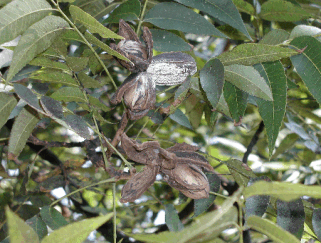 Figure 13. Shuck decline of pecan. The white fungi growing on the outside of the shuck is secondary and is not the cause of the shuck decline problem.
Figure 13. Shuck decline of pecan. The white fungi growing on the outside of the shuck is secondary and is not the cause of the shuck decline problem.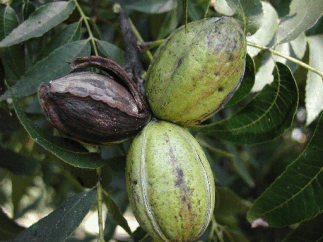 Figure 14. Nuts suffering from shuck decline may undergo shuck dehiscence prematurely. Nuts often remain in the shuck.
Figure 14. Nuts suffering from shuck decline may undergo shuck dehiscence prematurely. Nuts often remain in the shuck.
Most evidence points to fruiting stress as the primary trigger of shuck decline. Shuck decline normally occurs on trees bearing heavy fruit loads, which over-stresses pecan trees. Although apparent on many cultivars, shuck decline normally affects Stuart, Cape Fear, Moneymaker, and other prolific cultivars.
When shuck decline occurs, the problem is often hastened by dry soil during the kernel filling stage. This leaves pecan trees bearing heavy crop loads with insufficient water during the months of September and October when water is so very critical to the crop and to tree health. In such situations, many drip-irrigated orchards cannot keep up with the trees’ water demand. Drip-irrigated orchards may have sufficient soil moisture to develop large nut size; however, this makes the nuts more difficult to fill. As a result, drip-irrigated orchards can suffer as much or more from shuck decline as do dry-land orchards. Late season mite and aphid damage on an already heavily loaded and moisture stressed tree can create further stress.
Discussions of shuck decline can become somewhat confusing because of the similarity of symptoms caused by stress-induced shuck decline and those caused by other factors. An example of this is stem end blight, characterized by a grey-brown to black spot appearing near the proximal end of the immature shuck. The spot may enlarge and engulf the entire shuck. Fungicides have been shown to reduce the incidence of stem end blight, but have no effect on stress-induced shuck decline.
Many times disease pathogens are initially suspected as the primary problem when shuck decline occurs. However, multiple attempts have been made to isolate pathogens from shuck decline samples. Phomopsis sp. have been isolated from samples of shuck decline and from leaves with dieback. Phomopsis and other fungi such as Glomerella cingulata have been mentioned in literature associated with shuck decline in the past. These fungi appear to be opportunistic pathogens that are a problem on trees that are stressed. As with most opportunistic pathogens, Phomopsis and Glomerella are extremely difficult to control with fungicide applications.
Delayed Shuck Split / Vivipary/ Cracked Shells
From time to time shucks may not dehisce and open as they normally do. Some shucks on the tree may split, releasing the nut, while others may not. Occasionally, a high percentage of nuts fail to open while the shucks remain green (Figure 15). Often the kernel will be underdeveloped (Figure 16); sometimes the kernel will be well developed and mature. In such cases, the kernels remain extremely moist and the seed coat darkened.
 Figure 15. Nuts on the left are from a representative sample of a tree exhibiting delayed shuck split. Nuts on the right are from a tree which had normal crop development and shuck split.
Figure 15. Nuts on the left are from a representative sample of a tree exhibiting delayed shuck split. Nuts on the right are from a tree which had normal crop development and shuck split. Figure 16. Poorly developed kernels of green nuts exhibiting delayed shuck split (left); Normally developed kernels (right).
Figure 16. Poorly developed kernels of green nuts exhibiting delayed shuck split (left); Normally developed kernels (right).
If the kernel does not develop, the delayed shuck opening can be easily explained by the lack of ethylene, which is produced by the mature kernel to stimulate shuck split. A variety of factors may prevent kernel development. The cause of the delayed opening of green nuts with a mature kernel inside is unknown.
When green shucks fail to open and the kernel develops, there is often an increase in the number of nuts which germinate and sprout on the tree (Figure 17). This is termed vivipary. Vivipary often occurs under two conditions: (1) High humidity between the shell and shuck, and (2) high temperatures during ripening. The incidence of vivipary varies with crop load, irrigation, tree crowding, soil depth, and length of the growing season. The longer the fruit remains on the tree, the greater the degree of vivipary.
Since heavy fruit load and inadequate soil moisture are often associated with delayed shuck split and vivipary, mid-summer fruit thinning and adequate irrigation until shuck split can help minimize the problem in many situations.
With early harvesting or early nut maturity, thin-shelled cultivars with a tendency toward a high percentage of kernel-fill tend to crack when dislodged from the tree on sunny days (Figure 18). This happens because the shell dries at a faster rate than the kernel and the resulting pressure of the kernel against the shell causes the shell to break. On a sunny day, regardless of humidity, the nuts can crack within 15 minutes after falling from the tree.
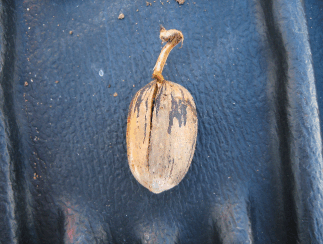 Figure 17. Premature germination or vivipary of pecan.
Figure 17. Premature germination or vivipary of pecan.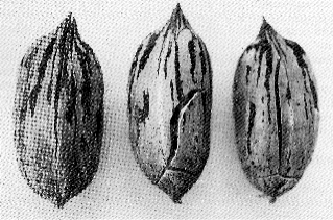 Figure 18. Shell cracking of thin-shelled ‘Wichita’ nuts following early harvest on a sunny day (Adapted from Sparks 1992).
Figure 18. Shell cracking of thin-shelled ‘Wichita’ nuts following early harvest on a sunny day (Adapted from Sparks 1992).
Freeze Damage
Occasionally late spring freezes occur after pecan foliage and, in some cases, after flowers have developed. Temperatures below 28 degrees F during late-spring freezes may severely damage pecan tissue. Damage often occurs in low areas in the orchard, on small trees, or on the lower limbs of larger trees due to the effect of elevation on temperature. If temperatures are cold enough, all of the tree’s foliage and developing flowers may be affected. In severe cases, the entire length of new tissue, including foliage, flowers and green stem growth, will be killed (Figure 19).
When freezing temperatures cause death of the pistillate flowers on the primary growth, secondary buds may break following the freeze and, on certain cultivars, produce a second crop of pistillate flowers. When freezing temperatures occur before pistillate flowers are fully functional, abnormal flowering may develop in which “perfect flower clusters” produce both pistillate flowers and catkins. In such cases, the catkin is often produced at the terminus or at the base of the pistillate flower cluster (Figure 20). Re-flowering may occur on at least 40 percent of the terminal shoots following a damaging freeze event.
 Figure 19. Pecan tissue damaged by a late spring freeze.
Figure 19. Pecan tissue damaged by a late spring freeze.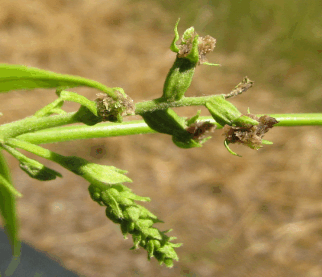 Figure 20. Abnormal flowering of ‘Desirable’ pecan on secondary growth, following a late spring freeze.
Figure 20. Abnormal flowering of ‘Desirable’ pecan on secondary growth, following a late spring freeze.
In many cases, when a second crop of flowers is produced, as little as 0-10 percent of those flowers develop into mature pecan fruit. The percentage of secondary fruit that is retained will depend on the stage primary flowers were in when the freeze occurred, as well as vigor, management and care of the trees before and after exposure to damaging temperatures. Certain cultivars, such as ‘Desirable,’ ‘Oconee,’ and ‘Cape Fear’ appear to re-flower more readily than others following freezing temperatures. In such cases, shoot length, leaf vigor, and leaf nitrogen, nickel, and zinc concentrations may be reduced. Other cultivars, such as ‘Kiowa’ may not develop a second crop of flowers; however, shoot growth is often increased.
References
Sparks, D. 1976. Nitrogen Scorch and the pecan. Pecan South 3: 500-501.
Sparks, D. 1976. Effects of fruiting on scorch, premature defoliation, and nutrient status of ‘Chickasaw’ pecan leaves. J. Amer. Soc. Hort. Sci. 102:669-673.
Sparks, D. 1989. Pecan nutrition-a review. Proc. S.E. Pecan Grow. Assoc. 82: 101-122.
Sparks, D. 1992. Pecan Cultivars: The Orchard’s Foundation, pp. 446. Pecan Production Innovations, Watkinsville, Ga.
Sparks, D. 1992. Abnormal flowering in pecan associated with freezing temperature. HortScience 27: 801-803.
Sparks, D., W.R. Reid, I.E. Yates, M.W. Smith, and T.G. Stevenson. 1994. Shuck decline in pecan induced by fruiting stress. Ann. Report Northern Nut Growers Assoc. 85: 70-84.
Stevenson, K.L. 2002. Premature Germination., p. 62. In Teviotdale, B.L., T.J. Michailides, and J.W. Pscheidt, eds. 2002. Compendium of Nut Crop Diseases in Temperate Zones, pp. 89. The American Phytopathological Society, St. Paul Minnesota.
Wells, M.L., and B.W. Wood. 2007. Relationships between leaflet Nitrogen: Potassium ratio and yield of pecan. HortTechnology (In Press).
Wood, B.W., C.C. Reilly, and A.P. Nyczepir. 2004. Mouse ear of pecan: I. Symptomatology and occurrence. Hortscience 39: 87-94.
Wood, B.W., C.C. Reilly, and A.P. Nyczepir. 2004. Mouse ear of pecan: II. Influence of nutrient applications. Hortscience 39: 95-100.
Wood, B.W., C.C. Reilly, and A.P. Nyczepir. 2004. Mouse ear of pecan: A nickel deficiency. Hortscience 39: 1238-1242.
Worley, R.E., and G.G. Taylor. 1972. An abnormal nut splitting problem of pecan. Hortscience 7: 70-71.
Status and Revision History
Published on Sep 17, 2007
Published on Sep 17, 2010
Published with Full Review on Sep 11, 2013
Published with Full Review on Apr 07, 2023


























































